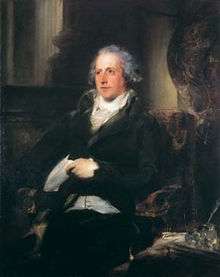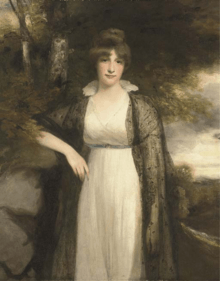William Eden, 1st Baron Auckland
| The Right Honourable The Lord Auckland FRS PC (Ire) | |
|---|---|
 | |
| President of the Board of Trade | |
|
In office 5 February 1806 – 31 March 1807 | |
| Monarch | George III |
| Prime Minister | The Lord Grenville |
| Preceded by | The Duke of Montrose |
| Succeeded by | The Earl Bathurst |
| Personal details | |
| Born | 3 April 1745 |
| Died |
28 May 1814 (aged 69) Beckenham, Kent |
| Nationality | British |
| Spouse(s) |
Eleanor Elliot (1758–1818) |
| Alma mater | Christ Church, Oxford |

William Eden, 1st Baron Auckland PC (Ire), FRS (3 April 1745 – 28 May 1814) was a British statesman and diplomat. The subantarctic Auckland Islands group to the south of New Zealand, discovered in 1806, were named after him.
Background and education
A member of the influential Eden family, Auckland was a younger son of Sir Robert Eden, 3rd Baronet, of Windlestone Hall, County Durham, and Mary, daughter of William Davison. His brothers included Sir Robert Eden, 1st Baronet, of Maryland, Governor of Maryland, and Morton Eden, 1st Baron Henley. He was educated at Durham School, Eton and Christ Church, Oxford,[1] and was called to the bar, Middle Temple, in 1768.
Political career
In 1771 Auckland published Principles of Penal Law, and soon became a recognized authority on commercial and economic questions. In 1772 he took up an appointment as Under-Secretary of State for the North, a post he held until 1778. He was Member of Parliament for Woodstock from 1774 to 1784 and served as a Lord of Trade from 1776 to 1782. In 1778 he carried an Act for the improvement of the treatment of prisoners, and accompanied the Earl of Carlisle as a commissioner to North America on an unsuccessful mission to bring an end to the American War of Independence. During the War, he was head of the British spies in Europe, his budget reaching £200,000 by 1778. He probably oversaw a small group of intelligence collectors for Lord Suffolk. On his return in 1779 he published his widely read Four Letters to the Earl of Carlisle. In 1780 Auckland became Chief Secretary for Ireland, which he remained until 1782, and was admitted to the Irish Privy Council in 1780. He represented Dungannon in the Irish House of Commons between 1781 and 1783 and was Joint Vice-Treasurer of Ireland between 1783 and 1784. While in Ireland he established the National Bank.[2]
Between 1784 and 1793 Auckland was Member of Parliament for Heytesbury. He was sworn of the British Privy Council in 1784 and served as Envoy to France from 1785 to 1787 (on a mission dealing with commerce); he was Ambassador to Spain between 1787 and 1789 and Ambassador to the Netherlands between 1789 and 1793. In 1789 he was raised to the Peerage of Ireland as Baron Auckland and in 1793 he retired from public service, receiving a pension of £2300, and was further honoured when he was made Baron Auckland, of West Auckland in the County of Durham, in the Peerage of Great Britain.
During his retirement in the country at Beckenham, he continued his intimacy with William Pitt the Younger, his nearest neighbour at Holwood House, who at one time had thoughts of marrying his daughter (see below). With Pitt’s sanction he published his Remarks on the Apparent Circumstances of the War in 1795, to prepare public opinion for a peace.[2]
He was later included in Pitt's government as Joint Postmaster General in 1798. He severely criticized Pitt’s resignation in 1801, from which he had endeavoured to dissuade him, and retained office under Henry Addington. This terminated his friendship with Pitt, who excluded him from his administration in 1804 though he increased his pension, but he later and served under Lord Grenville as President of the Board of Trade in the Ministry of All the Talents between 1806 and 1807.[2]
His Journal and Correspondence, published in 1861–1862, throws much light on the political history of the time.[2]
Family
Lord Auckland married Eleanor, daughter of Sir Gilbert Elliot, 3rd Baronet, and sister of Gilbert Eliott, 1st Earl of Minto, in 1776. They had six sons and eight daughters.
Their eldest son the Hon. William Eden was Member of Parliament for Woodstock but committed suicide in 1810. His daughter Elizabeth Eden married Francis Osborne, 1st Baron Godolphin.
Eleanor Agnes, the eldest daughter, became the subject of intense public interest in 1797 when it was rumoured that she was about to marry William Pitt the Younger, the Prime Minister; when the matter became public, however, Pitt denied absolutely that he had proposed to Eleanor, much to her father's fury.[3] In 1799 she married Robert Hobart, 4th Earl of Buckinghamshire. The fifth daughter, Mary Louisa, married Andrew Colville,[4] who was instrumental in opening up the Red River Colony to poor Scottish emigrants. The seventh daughter, Emily Eden, was a successful poet and novelist.
Lord Auckland died in May 1814 and was succeeded by his second but eldest surviving son, George, who was created Earl of Auckland in 1839. Lady Auckland died in May 1818.
References
- ↑ Lee, Stephen M.; rev. Sinéad Agnew. "Eden, William, first Baron Auckland (1744–1814)". Oxford Dictionary of National Biography (Sept 2004; online edn, May 2009). Retrieved 8 November 2009.
Eden was educated at Durham School (1755–8) and Eton College (1758–62) before going up to Christ Church, Oxford, in 1762.
- 1 2 3 4
 One or more of the preceding sentences incorporates text from a publication now in the public domain: Chisholm, Hugh, ed. (1911). "Auckland, William Eden". Encyclopædia Britannica. 2 (11th ed.). Cambridge University Press. pp. 893–894.
One or more of the preceding sentences incorporates text from a publication now in the public domain: Chisholm, Hugh, ed. (1911). "Auckland, William Eden". Encyclopædia Britannica. 2 (11th ed.). Cambridge University Press. pp. 893–894. - ↑ Hague, William William Pitt the Younger Harper Collins 2004
- ↑ Foster, Joseph. textsThe peerage, baronetage, and knightage of the British Empire : for 1882 (1883 ed.). Nicols & Sons. p. 646.